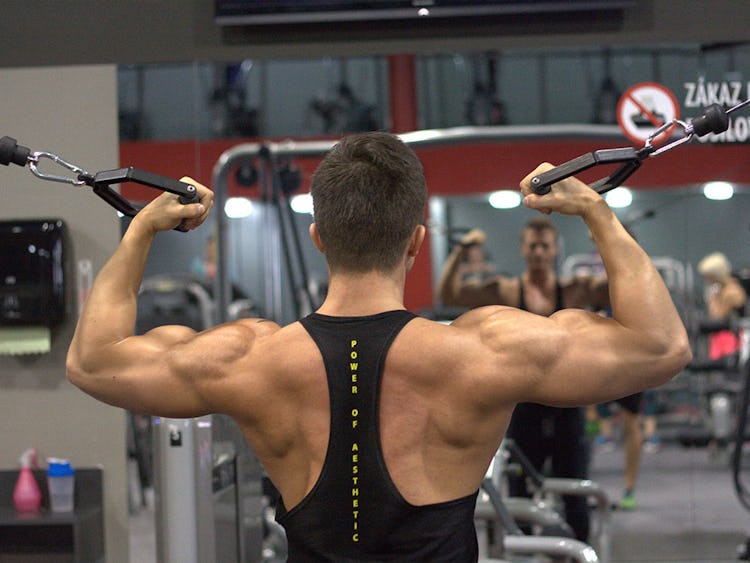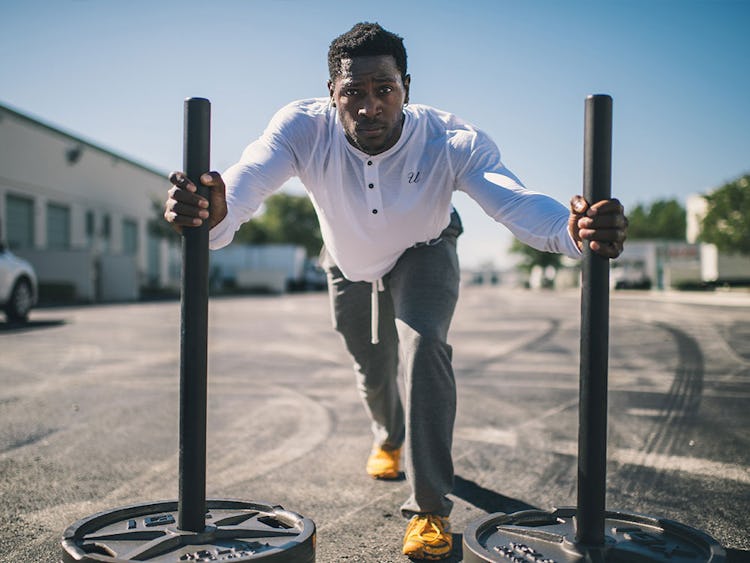The phrase “two-a-days” may bring back traumatic visions of repeated high school football practices in the blazing summer sun, or times when you tried to get your body into peak shape in a few weeks before a beach vacation. While the process may have been grueling, the concept might not have been so crazy after all. By packing in extra physical preparation, you can push your body to the next level, whether you want to perform better during a sports season, or just look your best naked. The fact is, training twice per day can help you reach your goal faster.
With the help of Bobby Maximus, owner of the Maximus Gym in Salt Lake City, and author of The Maximus Body (@bobbymaximus on Instagram), we’ve put together the quintessential guide to two-a-day training.
Benefits of Two-A-Day Workouts

It makes sense that the more work you put in, the better the results. That usually holds whether you’re studying for an exam, or trying to build muscle with strength training (but not always, as you’ll see below). According to a recent study in Medicine and Science in Sports and Exercise, training volume is the make or break factor that determines gains. The researchers discovered a “dose-response” relationship, where more sets led to greater improvements in muscle mass. Other research has found that training twice a day may better help your central nervous system adapt to exercise, and in turn improve your strength.
Two-a-days can also boost your stamina. Two studies (1, 2) showed that training twice a day can increase your endurance, and help your body burn fat and glycogen (stored carbohydrate) more efficiently.
But remember: too much of a good thing is bad. When subjected to higher training volumes, your body can adapt, but it needs time to do so, and there is a tipping point. If you’re putting in so much work that you can’t recover from your sessions, you’ll become overtrained, and you won’t see progress. Be warned: “If you have trouble recovering from one-a-days now,” says Maximus, “you shouldn’t be doing two-a-days.” Nutrition, sleep, stress management, and active recovery practices (foam rolling, massage, cold therapy, meditation, etc.) are hugely important for anyone to see gains, but they become even more so when doing two-a-days.
If you work too hard, too soon, and recover too little, you can hurt yourself. Research in the British Journal of Sports Medicine revealed that training-related injuries are largely due to excessive and rapid increases in work performed, but noted that high training volumes can actually help protect against injury as long as you ease into them.
The key is to up your workload gradually, and in a way that balances out your training. Maximus says to think opposites. “On days you train twice, train opposite energy systems or opposite movements. For example, weights in the morning and cardio at night, pushing exercises in the morning and pulling exercises at night, or lower body in the morning and upper body at night.”
This works because it “builds recovery in,” says Maximus. One energy system or group of stressed muscles rests while another works, maximizing training efficiency. You never hit any one area of the body or style of training (such as HIIT or long-duration cardio) more often than you can handle. The evening sessions complement the morning ones, and vice versa.
“Training twice per day by separating resistance training from a cardio metabolic workout allows you to perform better during each individual workout, without sending your body conflicting training signals,” says Eric Bach, C.S.C.S., a Georgia-based online performance coach (bachperformance.com). He adds that lifting twice a day is fine for those who want to bulk up, but you should train heavier, lower-rep exercises in the morning, and higher-rep, bodybuilder-esque accessory work in the evening. For instance, do your heavy squats and deadlifts in the a.m., and light dumbbell pressing and rows in the p.m.
None of this should give you the impression that bidaily wokouts are only for the most dedicated athletes. “Two-a-days are also a good approach for people who are busy and constantly racing the clock,” says Bach. “Breaking up your workouts can be an effective way to piece together a training plan for busy professionals and parents.” You could take the amount of training you were doing in one-hour sessions and simply split it in half, performing 30 minutes of training in the morning, and 30 minutes after work, if that better suits your schedule.
Is Working Out Twice A Day Bad for Building Muscle?

Two-a-days work by stressing your body more than it’s used to, forcing it to adapt faster. But if you don’t prioritize your recovery, you could overtrain and get injured. So the upside to two-a-day training is huge, but it comes at a higher risk. In addition to the guidelines Maximus and Bach gave above, consider the following to decrease that risk and improve your odds of making the best gains of your life.
First, both coaches say it’s key to have at least four to six hours between workouts. This will give your body enough time to rest and recover for the next round. Have a meal with protein and carbs after your first training session, and another small meal before your second session. This replenishes your energy stores and elicits the repair and rebuilding process. Maximus suggests you eat a meal that’s roughly 75% carbs and 25% protein (you don’t need to include fat at this time that isn’t a byproduct of your protein consumption). If you’re trying to bulk up, make sure this meal contains at least 500 calories.
“Don’t try to perform two full workouts in the same day,” says Bach. “You should cut back your training volume and do two shorter sessions. Doing less but better is a key to making two-a-day training work for you.” Streamline your workouts so that each session is 70–80% of what you’d usually do for a full-intensity workout.
Avoid any exercises that have plagued you in the past. If you’ve hurt your back deadlifting, this is not the time to add deadlifts back to your routine. Extra training can drain your recovery ability, and it may put your body in a more vulnerable state, setting you up for injury. Furthermore, the additional fatigue you’ll experience from the increased workload can compromise your form on lifts, especially ones you’re not proficient in or that have proven problematic for you in the past. By the same token, this is a good time to revisit old standby exercises that you know work for you and that you can perform safely.
For example, in the Advanced Two-A-Day plan below, one day calls for overhead squats. It’s a massively beneficial exercise, but many lifters struggle to do it with perfect form. If you’re one of them, find an easier swap, like rear-foot elevated split squats. Both exercises train the quads hard, but the split squat is easier on your lower back, and doesn’t require the same degree of shoulder and thoracic mobility.
Make sure your form on all your exercises is damn near perfect. “The biggest thing I tell people to watch is their knees and shoulders,” says Maximus. “The worst offenders for the knees are improper squats.” Maximus also stresses keeping your program balanced. “The shoulders get hurt when you do too much pushing [like bench pressing] without enough overhead work and pulling exercises [like rows and pullups].”
No matter what exercises you choose or how you set up your program, you’ll need to bulk up your recovery practices. “If you’re going to do two-a-days, you’re essentially doubling the stress on your body,” says Maximus. “So think of it in business terms: If your operating expenses double, you need to pay for that somehow. We pay for workouts through recovery practices—so plan on increasing your efforts there.”
For example, if you used to sleep seven hours a night, you may need to plan on getting eight or even nine. You might need to do more foam rolling, or get massages, or incorporate yoga and other stretching. “Whatever it is you usually do for recovery, double down on it,” says Maximus.
Understand that you don’t need to do two-a-days every day you work out, and if you haven’t been training long, you shouldn’t (see the sample schedules for two-a-days below). With all that said, you can do two-a-days for as long as you want, particularly if you feel healthy. Let your body be your guide—and know when to back off if you’re feeling down.
Sample Schedule for Multiple Workouts Per Day

The number of twice daily workouts you should perform each week depends on your training history.
If you’re new to training (or are coming back after a year or so off), you probably only want to perform two-a-day workouts once each week. “Dip your toe into the water rather than jump into the deep end,” says Maximus. “And, if after a couple of weeks, you feel good and like you’re acclimatizing well, then you can add on another two-a-day each week. And when you’re acclimatized to that, you can add another day, so you’re doing three a week.”
You can continue building up until you are doing four or five two-a-days a week, max (8–10 total workouts). Anything more than that, and you’re certain to get injured, say both Maximus and Bach. “How much people can take is often dependent on genetics, training history, how they pay attention to recovery, and more,” says Maximus. But a program of three or four two-a-days is plenty for most people and most goals.
Below, Maximus offers two sample two-a-day programs that will accelerate fat loss and muscle growth. Expect to get in the best shape of your life!
Two-A-Day Workout Plan for Beginners

If you’re a “I haven’t been in a gym for years…” type of beginner, then this plan isn’t for you. But if you’ve been lifting religiously for at least a few months and have hit a plateau, or you want to peak your fitness in a few weeks for an upcoming event, give this program a try. It’s a six-day a week schedule, but you’ll perform three two-a-day workouts per week. If that’s intimidating, ease in by selecting just one of the multi-session days, and build up to three from there.
Monday A.M.
Warmup: 10 minutes of easy cardio, just to break a sweat. You could use a rowing machine, ski erg, or run.
Cardio Workout: “Can’t” Vs “Won’t” Rowing
Set a rowing machine computer’s interval setting to 30 seconds of work and 90 seconds rest. Row 140 meters (115 for women), and stop there, even if you have time left in the 30-second interval. Rest 90 seconds. That’s 1 round. Next round, row 141 (or 116) meters and no more, followed by 90 seconds rest. Continue to add 1 meter to each round until you “can’t” or “won’t” go any farther.
Step 1. Sit on the rower and strap your feet down. Pick up the handle and extend your arms. Bend your hips and knees so that your shins are vertical and your chest is just behind your knees with your back straight. Your hips are behind your shoulders.
Step 2. Push through your legs until they’re extended, and then lean back slightly. Now row the handle to your chest. Keep your wrists straight and in line with your arms.
Step 3. Extend your arms, bend at the hips to close the angle between your torso and your legs, and then bend your knees to slide back to the starting position.
Cooldown: 10 minutes of easy rowing.
Monday P.M.
Warmup 1: 10 minutes of easy cardio.
Warmup 2: Take 10 minutes to practice and warm up with pullups, barbell bench press, barbell overhead press, and barbell bent-over row. Do light reps of each to prepare yourself for the workout.
Strength Workout: “Ticket To Gainzville”
Do the exercises as a circuit, completing one set for each in sequence. Do 10 reps of each exercise the first round, 9 reps the second, then 8, and so on until you’ve completed a final round of just 1 rep of each exercise. Choose a weight that makes it moderately difficult to complete the first 10 reps, and stick with it throughout (you may have to change weights for each barbell exercise). Rest as long as you need between circuits to complete the next round with good form (try starting at 2 minutes).
Bench Press
Step 1. Lie on the bench and arch your back, pulling your shoulder blades down and together. Grasp the bar just wider than shoulder width, and pull it out of the rack.
Step 2. Take a deep breath, tighten your glutes, and lower the bar to your sternum, tucking your elbows to your sides at 45 degrees on the descent. When the bar touches your body, push your feet into the floor and press the bar up at the same time.
Pullup
Step 1. Hang from a bar with your hands shoulder-width apart and your palms facing away. Pull your ribs down and keep your core tight.
Step 2. Draw your shoulder blades back and together and pull yourself up until your chin is over the bar. If your body weight isn’t challenging enough, attach extra weight with a belt, or hold a dumbbell between your feet.
Overhead Press
Step 1. Place a barbell in a power rack and grasp it with hands shoulder-width apart. Take the bar out of the rack and stand with feet shoulder-width apart. Rotate your elbows forward so that your forearms are vertical, and the bar is just below your chin. Tuck your pelvis slightly so that it’s parallel to the floor, brace your core, and tighten your glutes.
Step 2. Press the bar overhead, pushing your head through as the bar passes it. Shrug your shoulders at the top, and then lower the bar back down under control.
Bent-over Row
Step 1. Place a barbell on a rack set to hip level. Grasp the bar with your hands at shoulder width, and pull the bar out of the rack. Step back, and set your feet at hip width; hold the bar at arm’s length against your thighs. Take a deep breath, and bend your hips back—keep your head, spine, and pelvis aligned. Bend until your torso is nearly parallel to the floor.
Step 2. Draw your shoulder blades together as you pull the bar up to your belly button.
Core Workout: Pushup Plank Holds
Finish the workout with pushup plank holds. Hold the position for 30 seconds, and then rest 60 seconds. Repeat for 6 total sets. As you gain core strength, work up to 10 sets.
Pushup Plank Hold
Step 1. Get into a pushup position with hands shoulder-width apart and legs extended behind you. Tuck your pelvis so that it’s perpendicular to the floor, and brace your core.
Step 2. Hold the position, keeping your body straight from your shoulders to your heels.
Cooldown: 10 minutes of easy cardio.
Tuesday
Warmup: 10 minutes of easy cardio.
Cardio Workout: 30/30 Intervals
Use a rowing machine and row as hard as you can for 30 seconds. Rest 30 seconds. That’s 1 round. Do 6 total rounds, and then rest 4 minutes. That’s 1 block. Do 3 total blocks (you’ll have completed 18 total rounds).
Men should aim to row 150 meters each round. Women should shoot for 120.
Note: If you don’t have access to a rower, you can use a fan bike, stair stepper, or treadmill, and focus on the intensity rather than distance.
Cooldown: 10 minutes of easy cardio
Wednesday A.M.
Warmup: 10 minutes of easy cardio.
Cardio Workout: “The Long Road”
Row 500 meters in 2 minutes, and then rest 1 minute. That’s 1 round. Do 10 total rounds, trying to take 1 or 2 seconds off your time each round. So, for example, you’d want to finish your second round in 1:58, and your last round somewhere around 1:40.
Cooldown: 10 minutes of easy cardio.
Wednesday P.M.
Warmup 1: 10 minutes of easy cardio.
Warmup 2: Take 10 minutes to practice and warm up with the barbell deadlift, barbell bench press, pushup, pullup, and barbell back squat. Do light reps of each to prepare yourself for the workout.
Strength Workout: “555”
Do the exercises as a circuit, completing one set for each in sequence. Do 10 reps of each exercise the first round, 9 reps the second, then 8, and so on until you’ve completed a final round of just 1 rep of each exercise. Choose a light weight for the barbell exercises—one that you don’t have to work up to so that you can keep the circuit moving fast. We recommend no more than 135 pounds. Rest as needed between rounds of the circuit, but aim to finish the workout in 20 minutes.
Maximus calls this workout 555 because you do 5 exercises for 55 total reps each!
Bench Press
See the description from Monday.
Deadlift
Step 1. Stand with feet hip-width apart and tilt your tailbone back. Bend your hips back to reach down and grasp the bar with hands just outside your knees.
Step 2. Keeping a long spine with your head in line with your hips, take a deep breath into your belly, brace your abs, and drive through your heels. Pull the bar up along your shins until you’re standing with hips fully extended and the bar is in front of your thighs. Keep the bar pulled in tight to your body the whole time with your shoulder blades pulled together and down (think “proud chest”).
If you can’t keep your lower back flat throughout the exercise, it’s OK to elevate the bar on some weight plates or mats, as shown.
Pushup
Step 1. Place your hands on the floor, shoulder-width apart, and extend your legs behind you. Tuck your pelvis so that it’s perpendicular to the floor, and brace your core.
Step 2. Keeping your body straight from shoulders to heels, bend your elbows and lower your chest until it’s about an inch above the floor. Press yourself back up.
Pullup
See the description from Monday.
Squat
Step 1. Set up in a squat rack and grasp the bar with your hands as far apart as is comfortable. Step under the bar and squeeze your shoulder blades together and down, wedging yourself under the bar so that it rests on your traps or the back of your shoulders.
Step 2. Nudge the bar out of the rack and step back, setting your feet at shoulder width with your toes turned slightly outward. Without letting your feet actually move, try to screw both legs into the floor as if you were standing on grass and wanted to twist it up—you’ll feel your glutes tighten and the arches in your feet rise. Take a deep breath into your belly and bend your hips back, then bend your knees and lower your body down. Push your knees out as you descend.
Step 3. Go as low as you can while keeping your head, spine, and pelvis aligned, and then extend your hips and knees to return to standing.
Cooldown: 10 minutes of easy cardio.
Thursday
Warmup: 10 minutes of easy cardio.
Strength Workout Part A: “Gut Punch”
Grab two kettlebells or dumbbells (men should use 16-kilogram kettlebells or 35-pound dumbbells; women should use 12kg or 24 pounds)—and do 20 reps of each of the following exercises in circuit fashion. Rest 1 minute, and then do 15 reps, then 10, then 5. As you improve week to week, increase the number of reps you do. Build up to where you can complete sets of 50, 40, 30, and so on down to 10 reps.
Dumbbell Stepup
Step 1. Hold a weight in each hand and place your foot on a box or bench. It should be high enough so that your thigh is about parallel to the floor when the foot is resting on it.
Step 2. Step up onto the bench without letting your rear leg rest on it—let it dangle behind you. Step back down with the trailing leg. Do 10 reps on each leg (20 total).
Feet-to-Hands
Step 1. Hang from a pullup bar with your hands shoulder-width apart.
Step 2. Raise your feet to your hands. If that’s too tough, pull your knees to your elbows instead.
Strength Workout Part B: Pushups
Do 100 pushups, breaking them into however many sets you need to in order to complete all the reps. Tip: Don’t go to failure on any of the sets. For example, if you can do 20 reps when going all out, do sets of only 10 to 15. This will ensure you keep enough in the tank to reach the total without burning out.
Cooldown: 10 minutes of easy cardio.
Friday A.M.
Warmup: 10 minutes of easy cardio.
Cardio Workout: “Row To Hell”
Hop on a row machine and set its computer to “Single Distance.” Enter 500 meters into the computer. Row as hard as you possibly can until you finish 500 meters. Now rest as long as it took you to complete the 500-meter row. So, for example, if you rowed 500 meters in 1:30, you’d rest for 1:30. Repeat the process for 400 meters, and so on down to 100 meters.
Cooldown: 10 minutes of easy cardio.
Friday P.M.
Warmup: 10 minutes of easy cardio.
Strength Workout: “The Holy Trinity”
Set a timer for 30 minutes. Do as many reps of each of the three exercises as you can in circuit fashion, resting as needed, until the timer goes off. Tip: Don’t go to failure. Instead, cycle through small sets of each. If this feels like a lot, take longer rest breaks between exercises.
Pullup
See the description from Monday.
Dip
Step 1. Suspend yourself over parallel dip bars with hands just outside shoulder width. Lean slightly forward, and lower your body until your upper arms are parallel to the floor.
Step 2. Push yourself back up.
Pushup
See the description from Wednesday.
Core Workout: 100 Curlups
Take as many sets as you need to complete 100 total reps of the curlup.
Curlup
Step 1. Lie on your back on the floor with feet flat on the floor and knees bent.
Step 2. Slowly lift your shoulder blades off the ground, curling your torso upward while you slide your hands forward on the floor.
Cooldown: 10 minutes of easy cardio
Saturday
Perform steady-state cardio for 30–90 minutes. You can row, run, or bike at 70–90% of your max heart rate.
This is meant to be hard but not crushing. The goal is to get a really good sweat. If you like, you could do the workout “Fartlek” style. Fartlek is Swedish for “speed play.” That means an unstructured interval run, where you go from easy to moderate to hard efforts at random. Fartlek is fun to do with friends by playing games like follow the leader. There’s a huge mental benefit from this training due to its unpredictability. So, ditch your watch, your distance goals, and all your other numbers, and just go out, have fun, and keep it free flowing.
Sunday
Rest day
Advanced Two-A-Day Workout Plan
If you’ve trained regularly for years, and are ready to take your body and performance to the next level, this is the plan for you. It’s designed to help you build muscle, burn calories, and enhance your athleticism.
The program features five two-a-day workouts—the maximum allowable—which should be enough to bust any rut. However, it’s also a lot to recover from. If you feel run down at any point during the program, it’s OK to skip a training session, or reduce your intensity for a session or two. Make sure you’ve put in some time doing 3 two-a-days per week before you attempt five.
Monday A.M.
Warmup: Do the exercises in the order shown.
Wall Squat
Sets: 3 Reps: 5
Step 1. Stand facing a wall with your toes touching it.
Step 2. Squat as low as you can. (The wall is used to keep your torso upright.)
Bodyweight Squat
Sets: 2 Reps: 20
Step 1. Stand with your feet between hip and shoulder-width apart.
Step 2. Push back your hips, bend your knees, and squat as low as you can while keeping your back straight.
Walking Lunge
Sets: 3 Reps: 20
Step 1. Take a long step forward. As your foot lands, bend your knee and lower your body until your front thigh is parallel to the floor.
Step 2. Step forward with your rear leg and lunge on that side. Each rep should have you walking forward.
Strength Workout: Deadlifts
Deadlift
Sets: 4 Reps: 4
See the description in the beginner’s workout above. Slowly add weight to the bar, working up to about 80% of what you know or estimate you can lift for one perfect rep. Use that weight to perform 4 sets of 4 reps, resting 4 minutes between sets.
Core Workout: Pushup Plank Hold
See the description in the beginner’s workout above. Take as many sets as you need to complete 5 total minutes of holding, or as much time as you can.
Monday P.M.
Warmup: 10 minutes of easy cardio, just to break a sweat. You could use a rowing machine, ski erg, or run.
Strength Workout: Walking Lunge/Wall Sit Ladder
Do 20 walking lunges on each leg, and then immediately perform a wall sit, holding the position for 30 seconds. Next, do 19 walking lunges on each leg, and then immediately perform a wall sit, holding the position for 30 seconds. Continue the pattern, doing one fewer walking lunge on each leg, until you’ve performed just one lunge on each leg.
Walking Lunge
See the description from Monday a.m.
Wall Sit
Step 1. Get into a squat position with your back supported by a wall and your hips and knees 90 degrees.
Step 2. Hold the position.
Cooldown: 10 minutes of easy cardio
Tuesday A.M.
Cardio Workout: Perform 60 minutes of cardio at a pace that would allow you to easily hold a conversation. You could run, row, climb stairs, etc.
Tuesday P.M.
Cardio Workout: Perform 60 minutes of cardio at a faster pace than you used in your morning session. Think: a pace that would make it challenging to have a conservation. If possible, perform a different activity than you did in the morning.
Wednesday A.M.
Warmup: Do the exercises in the order shown.
Wall Squat
Sets: 2 Reps: 5
See the description from Monday.
Bodyweight Squat
Sets: 2 Reps: 10
See the description from Monday.
Goblet Squat
Sets: 2 Reps: 5
Step 1. Hold a dumbbell or kettlebell close to your chest and under your chin with both hands. Stand with feet between hip and shoulder-width and turn your toes out slightly.
Step 2. Push your hips back, bend your knees, and squat as deeply as you can while keeping your torso upright.
Walking Lunge
Sets: 2 Reps: 10 (each leg)
See the description from Monday.
Strength Workout: Barbell Complex and Front Squat
Do the exercises in the order shown. For the clean + front squat + hang clean complex, use a light weight that allows you to maintain good technique.
Clean + Front Squat + Hang Clean Complex
Set a timer for 20 minutes, and perform 1 rep of the complex every minute on the minute until the time is up. For example, when the clock starts (0:00), you’ll do one rep. Rest until that minute is up, and then perform your next rep when the clock reads 1:00.
Step 1. Hold the bar at hip level with arms straight and shoulder-width apart. Stand with feet between hip and shoulder-width.
Step 2. Keeping a long spine (a straight line from your head to your pelvis), push your hips back, and then quickly lock them out, using the momentum to pull the barbell up to shoulder height. Catch the bar at your shoulders, your palms facing the ceiling and upper arms parallel to the ground. The bar should be resting on your front delts.
Step 3. From this position, push your hips back, bend your knees, and descend into a front squat. Go down as fat as you can without your lower back rounding. Come back up.
Step 4. Lower the barbell back to your hips. Now put both moves back together into one: clean the bar up to your shoulders, immediately squat with it, stand back up, and lower it. That’s one rep.
Front Squat
Sets: 5 Reps: 2
Work up to a weight that’s 80–85% percent of your one-rep max, and use that load for your 5 sets of 2. Rest 2–3 minutes between sets.
Step 1. Set the barbell on a power rack and grasp it with hands shoulder-width apart. Roll your elbows under the bar so that they point forward, and lift the bar off the rack with arms parallel to the floor. Step back into your squat stance.
Step 2. Lower your body into the squat, and come back up.
Core Workout: Knees-To-Elbows
Perform 100 reps of knees-to-elbows, taking as many sets as you need. If that’s too hard, aim for 50 total reps, and build up from there.
Knees-To-Elbow
Step 1. Hang from a pullup bar with your hands shoulder-width apart.
Step 2. Bend your knees and raise them to your hands.
Wednesday P.M.
Warmup: Do the exercises in the order shown.
Wall Squat
Sets: 2 Reps: 5
See the description from Monday.
Bodyweight Squat
Sets: 2 Reps: 10
See the description from Monday.
Goblet Squat
Sets: 2 Reps: 5
See the description from Monday.
Walking Lunge
Sets: 2 Reps: 10 (each leg)
See the description from Monday.
Banded Shoulder Circles
Sets: 2 Reps: 10
Step 1. Stand holding an elastic exercise band (or dowel) with both hands outside shoulder width. Draw your ribs down, tuck your pelvis so it’s parallel to the floor, and brace your core.
Step 2. Keeping your arms straight, raise the band over and behind your head as far as you can. Reverse the motion to bring the band back in front of you.
Push Press Hold
Sets: 2 Reps: 10
Step 1. Grasp two light dumbbells and hold them at shoulder level. Stand with feet shoulder-width apart. Tuck your pelvis and brace your core.
Step 2. Dip your knees quickly and, keeping your torso upright, use the rebound to press the weights overhead to lockout. Complete 10 reps, holding the lockout position of the last one 30 seconds. Repeat for 2 total sets.
Strength Workout: Overhead Squat and Turkish Getup
Do the exercises in the order shown.
Overhead Squat
Sets: 5 Reps: 10
Step 1. Load a bar with a light weight and grasp it with hands wider than shoulder width. Press the bar overhead, and get into your squat stance.
Step 2. Squat down, keeping the bar behind your head and a long line from your head your pelvis. Rest 2 minutes between sets.
Turkish Getup
Sets: 1 Reps: 6 (each side)
Step 1. Lie on your back on the floor and hold a kettlebell or dumbbell over your chest with your right hand. Bend your right knee and plant that foot; extend your left arm out at 45 degrees and push your hand into the floor for stability.
Step 2. Roll your torso up off the floor, using your left arm for support. Keep the kettlebell overhead and pointing to the ceiling. Drive your right foot into the floor to bridge your hips up, and swing your left leg under you to rest on your left knee.
Step 3. Windshield wiper the left lower leg so it’s in line with the right leg, and you’re resting in the bottom of a lunge.
Step 4. Stand up tall, with the weight still raised overhead.
Step 5. Reverse the steps to return to the floor. Complete 6 reps on the right side and then 6 on the left. That’s one set. Rest 1–2 minutes between sets.
Cooldown: 10 minutes of easy cardio.
Thursday A.M.
Warmup: 10 minutes of easy cardio.
Cardio Workout: “Can’t” Vs “Won’t” Rowing
Set a rowing machine computer’s interval setting to 30 seconds of work and 90 seconds rest. Row 140 meters (115 for women), and stop there, even if you have time left in the 30-second interval. Rest 90 seconds. That’s 1 round. Next round, row 141 meters (or 116) and no more, followed by 90 seconds rest. Continue to add 1 meter to each round until you “can’t” or “won’t” go any farther.
Cooldown: 10 minutes of easy cardio.
Thursday P.M.
Warmup: 10 minutes of easy cardio.
Strength Workout
Do the exercises in the order shown. For the barbell overhead press, slowly work up to a weight that is 80% of what you think you can lift for a one-rep max. Use that load for all 4 sets, resting 3 minutes between sets.
Overhead Press
Sets: 4 Reps: 4
See the description in the beginner’s workout.
Bent-over Row
Sets: 10 Reps: 10
See the description in the beginner’s workout.
Push Press Hold
Sets: 4 Reps: 10
See the description from Wednesday.
Cooldown: 10 minutes of easy cardio
Friday A.M.
Warmup: Do the exercises in the order shown.
Wall Squat
Sets: 2 Reps: 5
See the description from Wednesday.
Bodyweight Squat
Sets: 2 Reps: 10
See the description from Wednesday.
Goblet Squat
Sets: 2 Reps: 5
See the description from Wednesday.
Walking Lunge
Sets: 2 Reps: 10 (each leg)
See the description from Wednesday.
Strength Workout: Back Squat and Wall Sit Hold
Do the exercises in the order shown.
Squat
Sets: 9 Reps: 8
See the description in the beginner’s workout. Work up to 90% of what you estimate to be your one-rep max and perform 1 rep. Then back off to 55% of your max and perform 8 sets of 8 reps, resting 2 minutes between sets.
Wall Sit
Sets: 10 Reps: Hold for 30 seconds
See the description from Monday.
Cooldown: 10 minutes of easy cardio
Friday P.M.
Cardio Workout: Perform 60 minutes of cardio at a pace that would allow you to easily hold a conversation. You could run, row, climb stairs, etc.
Saturday
Warmup: 10 minutes of easy cardio.
Strength Workout: “The Holy Trinity”
Set a timer for 30 minutes. Do as many reps of each of the three exercises as you can in circuit fashion, resting as needed, until the timer goes off. Tip: Don’t go to failure. Instead, cycle through small sets of each. If this feels like a lot, take longer rest breaks between exercises.
Pullup
See the description in the beginner’s workout.
Dip
See the description in the beginner’s workout.
Pushup
See the description in the beginner’s workout.
Core Workout: 100 Curlups
Take as many sets as you need to complete 100 total reps of the curlup.
Curlup
See the description in the beginner’s workout.
Cooldown: 10 minutes of easy cardio
Sunday
Rest day

)





